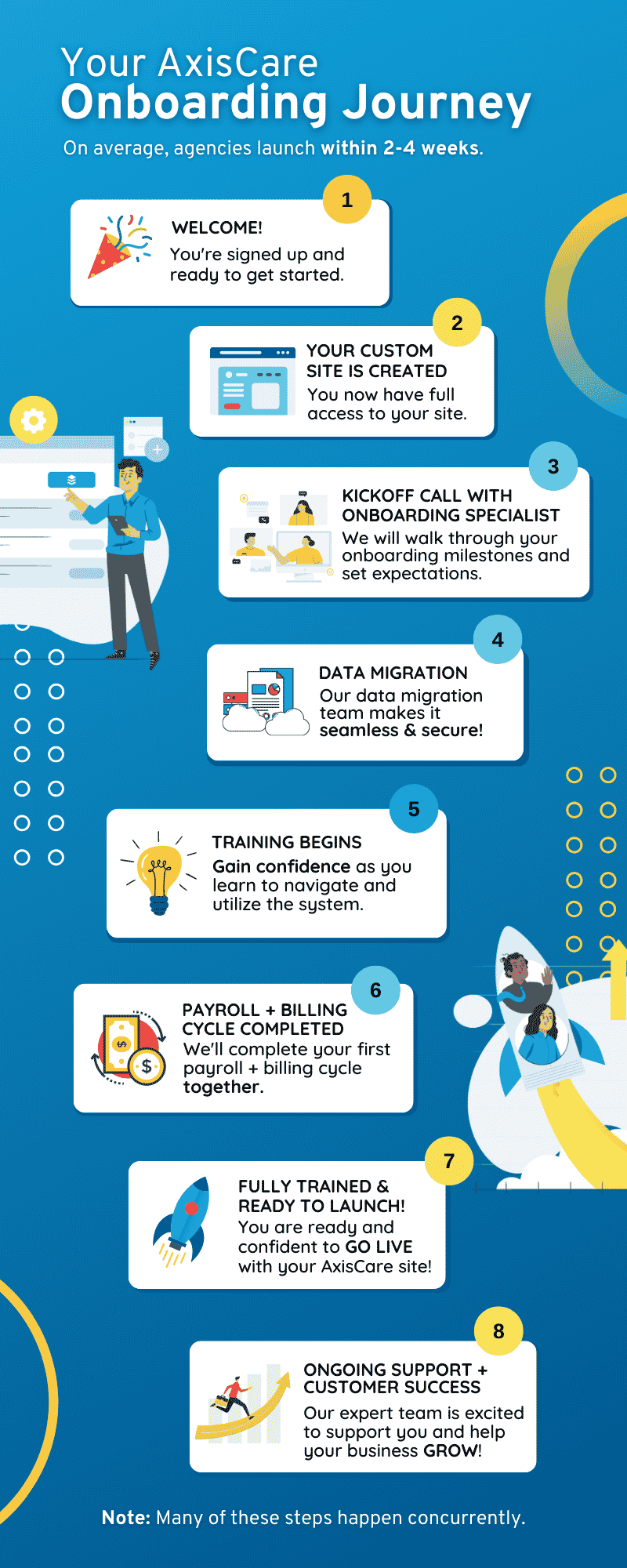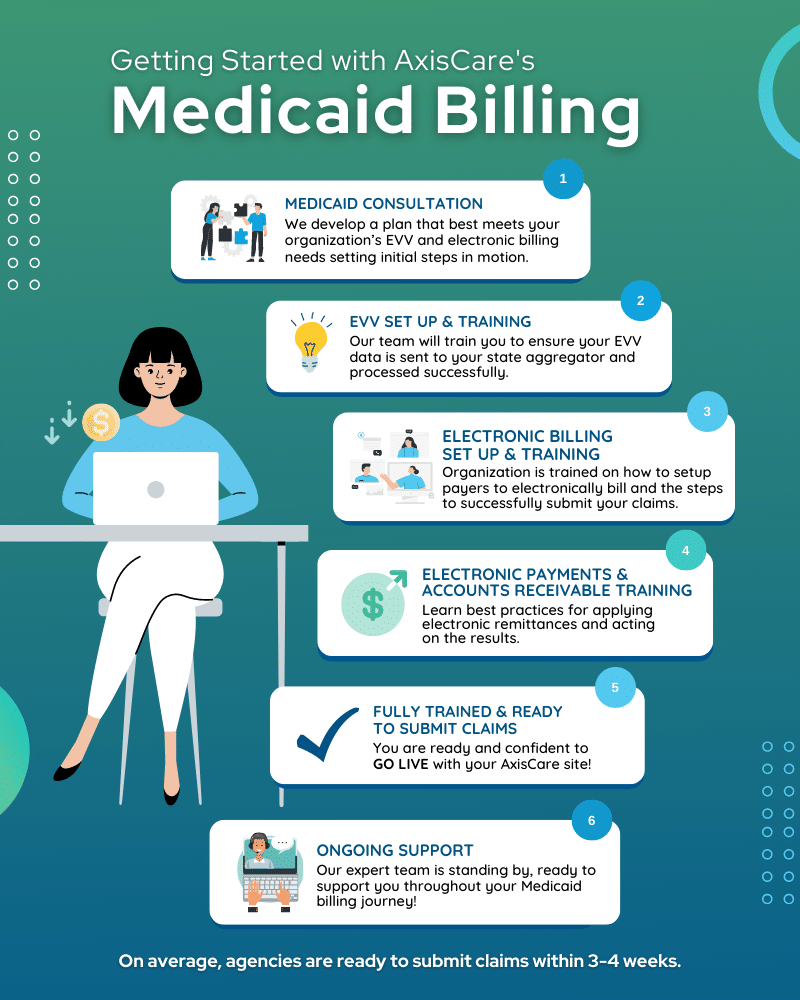Billing can make or break a home care agency’s financial health. When processes run smoothly, agencies enjoy healthy cash flows, on-time reimbursements from Medicaid and other payers, and issue-free claim approvals. But without the proper systems in place, documentation errors and claim denials can grind cash flows to a halt.
The latter situation happens more often than it should, and agencies could be forgiven for their oversights. Compliance in home care is no easy feat: agencies must juggle multiple payer requirements and maintain airtight documentation while providing complex individualized care.
In this piece, we’ll explore the five most common barriers to billing excellence and how to overcome them using the right tools and technologies. Get it right, and your agency will not only be in peak financial health, but also in a position to deliver the best possible care for your clients.
Challenge 1: Denied Claims – Causes & Solutions
It doesn’t take much for an insurance, Medicare, or Medicaid claim to get kicked back. Even the smallest of errors or omissions can result in a denial, leaving agencies to deal with the administrative burden while waiting for reimbursement. These challenges can usually be traced back to improper documentation: if caregivers cannot log visit notes and client information in a standardized format, it creates inconsistencies that disrupt cash flow and continuity of care.
Common Reasons for Denials
Claims may be denied due to an incorrect service code, missing information, or failure to meet a filing deadline. Even a small typo, such as an incorrectly entered Medicare ID or insurance policy number, can invalidate a claim.
If visit records and the associated care plans differ or notes are vague, payers may also kick back a claim. Coding errors or mismatched codes with services rendered can yield the same result. If agencies fail to track authorization limits or changes in coverage, they may run into approval issues when prior authorizations are missing, expired, or exceeded.
Best Practices to Reduce Denials
Your employees are an important line of defense against simple errors that can produce denials. Providing ongoing training that familiarizes them with common documentation and coding errors is an important baseline, accompanied by checklists and refresher sessions to keep them up-to-date on payer requirements and coding norms.
To make their job infinitely easier, EVV-integrated platforms and billing software automates the verification process for faster and more accurate resolutions. It can detect missing data, incorrect codes, or mismatched authorizations and flag them for resolution before a denial-bound claim is even submitted.
Challenge 2: Navigating Complex Billing Codes & Regulations
Every home care service is associated with its own unique code, which is used to verify that the services delivered match the client’s care plan and are billed accurately for reimbursement. Agencies need to keep track of multiple coding systems at once: ICD (International Classification of Diseases) codes identify diagnoses, CPT (Current Procedural Terminology) codes describe different services, and HCPCS (Healthcare Common Procedure Coding System) codes are associated with supplies, equipment, and certain services not covered under CPT.
To complicate matters further, these codes are usually updated on an annual basis to reflect new medical standards, emerging treatments, or changes in reimbursement policies. And for a final layer of complexity, payer-specific guidelines (such as state-level Medicaid programs and private insurers) have vastly different requirements for how codes should be documented and submitted. Formatting that’s accepted by one payer might be flagged by another, requiring agencies to tailor their billing practices to each situation.
Updates in Billing Codes & Guidelines
Frequent code updates are a minefield for billing teams: using an outdated code or failing to follow the latest payer instructions is a one-way ticket to denied claims, delayed reimbursement, and even compliance penalties. Billing and EVV software will integrate these policy updates automatically, reducing the risk of human error and ensuring claims reflect the most up-to-date standards.
From a proactive standpoint, agencies can supplement their compliance efforts by tracking authoritative sources like the Centers for Medicare & Medicaid Services (CMS), payer bulletins, and state health department resources. Subscribing to official newsletters or portals is also great for receiving inbound updates as soon as new information becomes available.
Challenge 3: Delayed Payments & Cash Flow Management
Delayed payments can create a ripple effect that touches every corner of a home care agency’s operations. Whether the reason is an error on a claim, manual or inefficient billing processes, or slow payer processing timelines, the connection is clear. Inaccurate or incomplete documentation triggers a denial, which extends the billing cycle, delays reimbursement, and forces agencies into a financial scramble as they wait for a resolution.
Impact of Payment Delays
When claims are rejected or held up due to errors, agencies’ cash flows are disrupted, making it difficult to handle payroll, pay vendors, or invest in resources that support growth. For smaller or mid-sized agencies, these delays can pose an existential threat, drilling holes in their ships that take on water until they eventually sink.
To proactively manage these risks, agencies need to keep tabs on financial metrics like claim denial rates, average time to reimbursement, and cash-reserves-to-payroll ratio. Regularly tracking these indicators allows agencies to identify bottlenecks and take corrective actions to plug critical gaps and maintain operational stability.
Technology & Process Improvements
Billing automation is the key to solving issues related to manual entry. These platforms also standardize claim formatting and ensure compliance with payer-specific rules, which further reduces the risk of denials.
Once a claim is sent off, real-time tracking gives administrators valuable visibility, enabling them to quickly identify and resolve issues before they spiral into delayed payments. Going one step further and integrating billing with EHR creates a seamless flow between documentation, visit verification, and care records to improve accuracy and cut down on admin time.
Challenge 4: Inefficient Tracking of Billable Hours & Services
To make sure each claim is compliant with payer demands, caregivers have a responsibility to track the details of every visit. While that may sound straightforward enough, the process is actually rife with complexities: shifts that span multiple caregivers, overlapping visits, and variable service types are all a challenge to pin down.
Difficulties in Time Tracking for Home Care
Variable shift structures like split shifts, overnight care, or flexible weekend hours can make it difficult to pinpoint start and end times, leading to discrepancies in billed hours. The same is true when multiple caregivers serve the same client during a single day: overlapping visits or failure to hand off the necessary documents can result in double-billing or gaps that trigger payer audits.
When caregivers are caught up in the whirlwind of moving from place to place, they might also miss a check-in by accident. If connectivity issues pop up without warning, they may need to manually log information for certain visits, which risks creating gaps in a client’s official record if not re-inputted properly. As always, these challenges can eventually lead to claim denials if not resolved.
Integrating Time Tracking With Billing Software
Integrating time tracking directly into billing platforms seamlessly connects data captured through EVV or scheduling systems to billing workflows. This speeds up invoicing turnarounds while reducing the need for duplicate entry and, therefore, the risk of human error. Home care agencies are best served by tech platforms that can sync service data in real time, supported by a mobile app that enables caregivers to log details while in the field.
Challenge 5: Ensuring Regulatory & Compliance Adherence
Home care agencies operate at the nexus of multiple overlapping yet very distinct regulations. At the federal level, HIPAA establishes strict standards for protecting client data during billing and claims processing. States also have their own Medicaid-specific billing and documentation standards layered on top, usually accompanied by EVV mandates and coding requirements. On top of all that, payers like Medicare, Medicaid, and private insurers have their own rules for how claims must be documented and submitted.
Where there is compliance, there is audit risk. Agencies should always be prepared to produce the necessary documents for state regulators, CMS, or commercial payers to verify that their bills accurately reflect the care delivered.
Strategies to Maintain Compliance
Effective compliance in home care billing is all about staying proactive and focusing on prevention: double-checking your work before sending off a claim is much less laborious than getting tangled up in a denial resolution.
Periodic staff training and internal audits will keep employees plugged into the latest compliance standards and help catch errors in their tracks, thereby reducing the risk of denials and penalties. Agencies should also leverage compliance and billing platforms with built-in alerts, audit trails, and real-time error checking to further emphasize prevention over correction.
Overcome Home Care Billing Challenges With AxisCare
Billing and compliance go hand in hand, and the right home care software will treat them as such. Request a free live demo to learn how AxisCare can support your agency’s operations from every angle.









